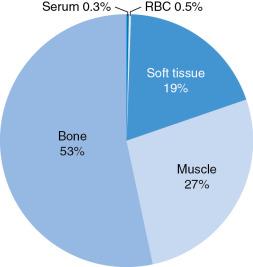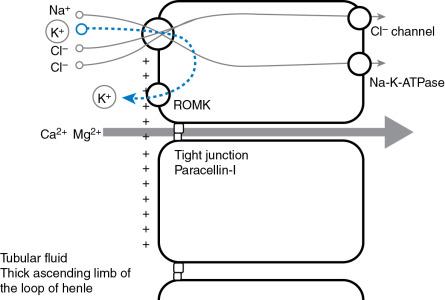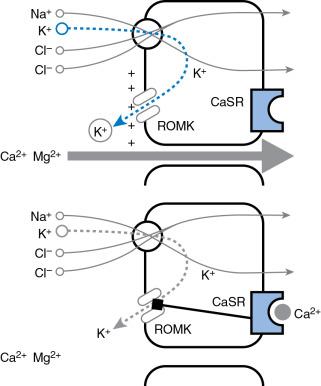Physical Address
304 North Cardinal St.
Dorchester Center, MA 02124
The molecular weight of magnesium is 24.3 g/mol, with a 2+ valence (Mg2+). The normal serum magnesium level is 0.7 to 0.85 mmol/L, but it is often expressed as equivalents per liter, 1.4 to 1.7 mEq/L (mEq/L = mmol/L × valence), or in conventional units, 1.7 to 2.1 mg/dL (mg/dL = mmol/L × molecular weight divided by 10). Normal reference levels vary from laboratory to laboratory ( Table 77.1 ).
| UNITS | NORMAL MAGNESIUM CONCENTRATION |
|---|---|
| mmol/L | 0.7–0.85 mmol/L |
| mEq/L | 1.4–1.7 mEq/L |
| mg/dL | 1.7–2.1 mg/dL |
| mg/L | 17–21 mg/L |
The average human body contains a total of 25 g of magnesium, which is roughly equivalent to 2000 mEq or 1 mole of magnesium. Nearly 99% of this magnesium is intracellular, with just over half trapped in bone. Only 1% is extracellular, a third of which (2.6 mmol) is present in plasma ( Fig. 77.1 ). Like calcium, only the ionized fraction of magnesium is metabolically active, and represents 55% to 70% of serum magnesium.

The intracellular magnesium concentration is 10 to 20 mM/L; however, the majority of this magnesium is bound to adenosine triphosphate (ATP), while a smaller potion is bound to nucleotides and proteins. Only 5% of the cytosolic magnesium (0.5 to 1 mM/L) is unbound.
Magnesium is a critical cofactor for over 600 enzymatic reactions. It maintains the stability of ATP as well as the tertiary structure of DNA. Given magnesium’s central role in ATP generation, it should not be a surprise that magnesium is important for muscle contraction, relaxation, normal neurological function, and release of neurotransmitters. Magnesium also has a role in DNA replication and repair, RNA transcription, amino acid synthesis, protein formation, and glucose metabolism.
There is evidence that magnesium has a role in insulin secretion, and some clinical trials have shown improved metabolic profiles in diabetics given magnesium supplementation.
Dietary sources of magnesium are primarily dark leafy vegetables, whole grains, nuts, beans, and seafood. A typical Western diet contains less than the FDA recommended 420 mg for males and 320 mg for women, because the soil in which fruits and vegetables are grown is depleted of magnesium. Also, Western diets are rich in refined grains, and as much as 90% of the Mg is lost in processing. Hard water is a source of dietary magnesium. Globally, magnesium intake has dropped due to increased consumption of processed (refined) grains and increased water softening.
Only about a quarter, or 100 mg, of the ingested magnesium is absorbed by the GI tract and the rest is excreted. Much of the absorption takes place through passive paracellular transport, driven by an electrochemical gradient and solvent drag. There is a second active transport system mediated by TPRM 6 and 7 channels (TRPM stands for “transmembrane receptor potential subfamily melastatin”). The active magnesium transport becomes more active with low magnesium status and is downregulated with magnesium excess. This active transport system is more active in the terminal ileum and proximal colon ( Fig. 77.2 ).

Unlike most other electrolytes, where absorption takes place in the proximal tubule, magnesium reabsorption occurs predominantly at the thick ascending limb of the loop of Henle (TAH). That being said, roughly 20% of filtered magnesium is reabsorbed in the proximal tubule. About 70% of the filtered magnesium is absorbed in the thick ascending loop of Henle. This occurs through paracellular tight junctions down the electrical gradient. The electrical gradient is established by the renal outer medullary potassium (ROMK) channel, which allows intracellular potassium to flow into the tubule. Potassium is the rate-limiting reagent for the sodium, potassium, two chloride (NK2Cl) channel ( Fig. 77.3 ).

The kidneys are able to dynamically adjust the reabsorption of magnesium to respond to changes in magnesium levels. In the presence of low magnesium, fractional reabsorption of magnesium can rise to 99.5%. With magnesium excess, the fractional excretion of magnesium can fall to 30%.
No known hormone has any appreciable effect on renal magnesium handling.
Become a Clinical Tree membership for Full access and enjoy Unlimited articles
If you are a member. Log in here